I wish I could tell you that after turning 50, there are health issues associated with age I plan to be mindful of and address proactively. Unfortunately, that ship has sailed for me well more than a decade ago. So, I share this medical information, not only as a health professional but also as an experienced senior.
Entering the fifth decade is not all dome and gloom. Often, this decade is associated with an established family, gratifying career, good health and acquired self-confidence…realizing that life does not have to be perfect to be wonderful!
However, research tells us that as the body ages, even small changes at the cellular level can be manifested into big changes and problems over time. Nine of ten older adults have some type of chronic disease and eight of ten have more than one. But the good news is that, with a modicum of effort, most of these illnesses can be controlled or prevented, including regular doctor visits, health screening and testing, and lifestyle changes.
While it is normal to experience some weight gain is expected with age. However, uncontrolled, the average person will gain 1-2 pounds per year, leading to 11 pounds per decade, according to the National Institutes of Health. Consequently, almost 45% of Americans between 40 to 60 are obese. Obesity is associated with at least 20 chronic illnesses such as high blood pressure, heart disease, diabetes, cancer, and arthritis.
SCREEN: Body Mass Index (BMI)
TREATMENT: Diet, Exercise, Lifestyle, Medications, Surgery
With age, the flexibility of blood vessels loses elasticity and, unchecked, two out of three adults over 60 have high blood pressure. While genetics is a factor, there are a few things that you can control such as diet (salt, calories), exercise, weight, stress, and smoking.
SCREEN: Blood Pressure Test, Lab Tests, Electrocardiogram (ECG/EKG)
TREATMENT: Diet, Exercise, Lifestyle, Medications
Plaque buildup in the arteries of the heart begins in childhood and advances rapidly with age. 6-7 percent of US adults between the ages of 40 and 60. 20% of men and almost 10% of women between the ages of 60 and 80 have heart disease.
SCREEN: Blood Pressure, Cholesterol testing, Blood Sugar Testing, Imaging (ECG/MRI)
TREATMENT: Diet, Exercise, Lifestyle, Medications, Surgery
10 % of Americans have diabetes and the percent only increases with age. Diabetes is associated with many serious chronic illnesses such as heart disease, blindness, kidney disease and others.
SCREEN: Blood Test for blood sugar levels such as A1C, fasting plasma glucose test and random plasma glucose test
TREATMENT: Diet, Exercise, Lifestyle, Medications
In many cases osteoarthritis (wear and tear of joints) is often associated with age. However, lifestyle, joint injuries, inactivity, obesity and diabetes play a significant role.
SCREEN: Physical Exam, Functional Scores, Xrays, MRI, CT, US
TREATMENT: Diet, Exercise, Physical Therapy, Lifestyle, Medications (NSAID’s, Steroids, Viscosupplementation), Bracing, Surgery
Loss of bone density and strength is associated with age and certain metabolic conditions such as early menopause, thyroid disease, prolonged use of blood thinners and steroids. However, a diet rich in vitamin D, regular weight bearing exercises such as walking, jogging, dancing etc can go a long way.
SCREEN: Fracture Risk Assessment Tool (FRAX), Dual-Energy X-Ray Absorptiometry (DEXA) TREATMENT: Diet, Exercise, Physical Therapy, Lifestyle, Medications (Oral and Injection)
Losing balance with age is a common problem due to changes in the vestibular system (balance system in the brain), loss of muscle strength and joint flexibility, and compromised vision and hearing. This can often lead to falls, head injuries and fractures.
SCREEN: Timed Up and Go (TUG) Test, Morse Fall Scale
TREATMENT: Physical Therapy – Falls Prevention Program/Balance Training , Diet, Exercise, Lifestyle, Environmental Modification, Vision/Hearing Testing
Almost 10% of adults between the ages of 55 and 65 have some form of vision and/or hearing loss. This can lead to many problems such as balance and falls as well as isolation and depression.
SCREEN: Regular Hearing Tests/Vision Testing
TREATMENT: Corrective Devices
Both men and women suffer from bladder problems with age... especially frequency and control. It can impact lifestyles in many ways. Often adults fail to hydrate properly, especially when traveling, to control urgency. This can lead to other health problems.
SCREEN: Urine Analysis, PSA, Imaging, CT Urogram, Urine Cystoscopy, Ultrasound,
TREATMENT: Diet, Exercise, Lifestyle, Avoid Caffeine and heavy lifting, Medications, Surgery
As the body ages, so too do the cells that make it up. Often these cells change into cancer different parts of the body. Skin, colon, breast, prostate, lung, throat, etc. Today, however, much progress has been made for early detection and treatment.
SCREEN: Physical Exam (Skin Exams), Lab Tests (blood work, PSA), Imaging (CT, Mammography, MRI), Genetic Testing, Pap Smears, HPV Tests, Colonoscopies/Stool Tests, Multi-Cancer Early Detection (MCED)
TREATMENT: Diet, Exercise, Physical Therapy, Lifestyle, Medications, Chemotherapy, Radiation, Immunotherapy and Targeted Therapy Surgery specific to the cancer type.
Age related mental health issues are vastly unreported and diagnosed. Medical problems can contribute to mental health such as high blood sugar levels and some infections. Overall, lifestyle, environmental factors and family structure and support are particularly important.
SCREEN: No Single Test – Combination of Tools including - Neurological and Cognitive Tests, Brain Scans (CT/MRI), Blood tests, Genetic Testing
TREATMENT: Diet, Exercise, Physical Therapy, Lifestyle, (avoid excessive toxins like alcohol and nicotine), Medications, Environmental Modifications.
SOURCES: WebMD, NIH, Mayo Clinic, Alzheimer’s Association, American Cancer Society, American Heart Association, American Diabetes Association

EVERY MONDAY – Read Dr. Paul J. Mackarey “Health & Exercise Forum!” via Blog
EVERY SUNDAY in "The Sunday Times" - Read Dr. Paul J. Mackarey “Health & Exercise Forum!” in hard copy
This article is not intended as a substitute for medical treatment. If you have questions related to your medical condition, please contact your family physician. For further inquires related to this topic email: drpmackarey@msn.com
Paul J. Mackarey PT, DHSc, OCS is a Doctor in Health Sciences specializing in orthopedic and sports physical therapy in Scranton and Clarks Summit. Dr. Mackarey is in private practice and is an associate professor of clinical medicine at Geisinger Commonwealth School of Medicine. For all of Dr. Mackarey's articles, visit our exercise forum!
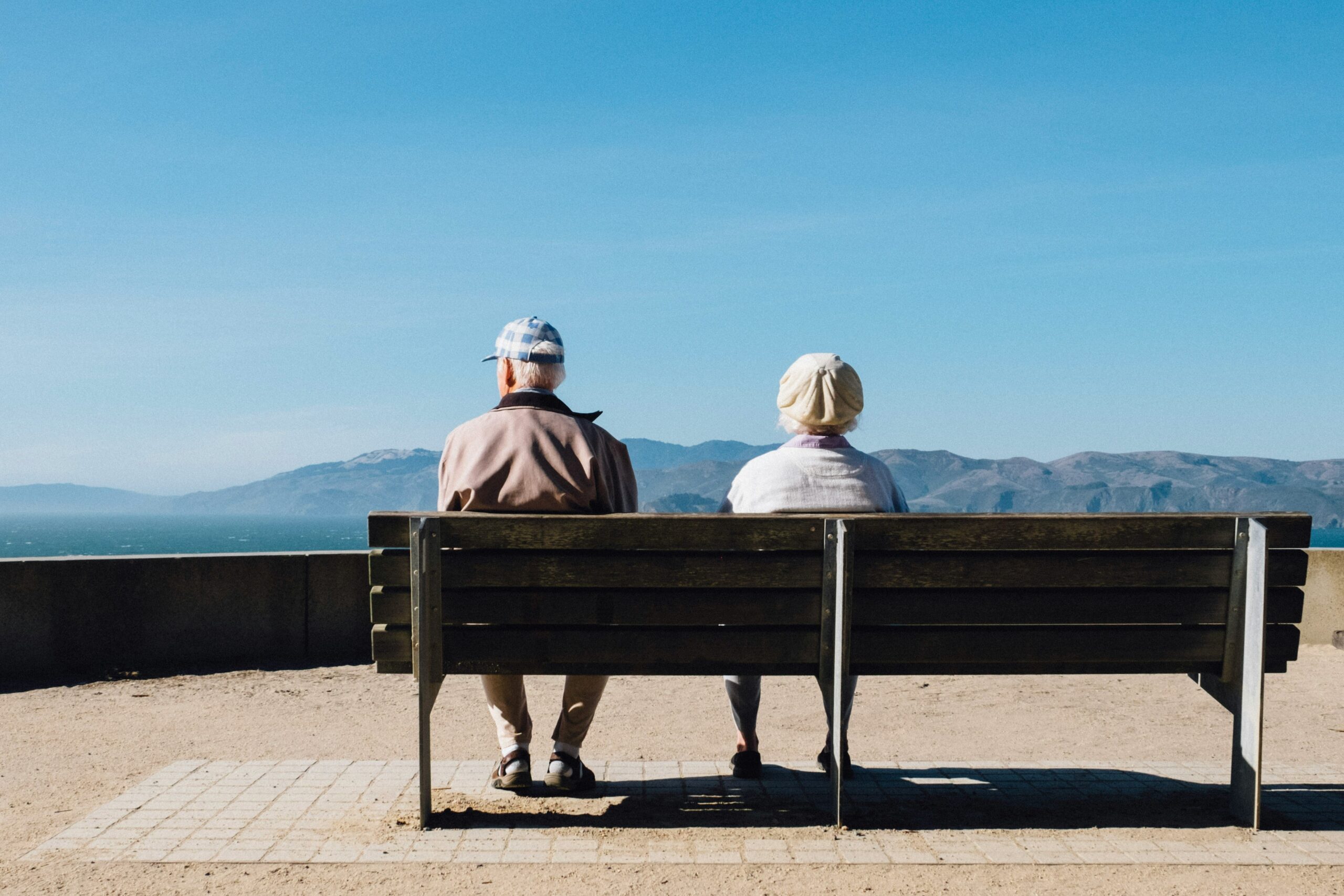
While I normally do not address the topic of shoveling snow until January, considering recent weather events, I thought it might be valuable to present it sooner. Much has been written about the dangers of snow shoveling for your heart. However, while not fatal, low back pain is the most common injury sustained while shoveling snow. Heart attacks are also more common following wet and heavy snow.
Snow shoveling can place excessive stress on the structures of the spine. When overloaded and overstressed, these structures fail to support the spine properly. The lower back is at great risk of injury when bending forward, twisting, lifting a load, and lifting a load with a long lever. When all these factors are combined simultaneously, as in snow shoveling, the lower back is destined to fail. Low back pain from muscle strain or a herniated disc is very common following excessive snow shoveling.
Sources: The Colorado Comprehensive Spine Institute; American Academy of Orthopaedic Surgeons
Visit your doctor regularly and listen to your body.

EVERY MONDAY – Read Dr. Paul J. Mackarey “Health & Exercise Forum!” via Blog
EVERY SUNDAY in "The Sunday Times" - Read Dr. Paul J. Mackarey “Health & Exercise Forum!” in hard copy
This article is not intended as a substitute for medical treatment. If you have questions related to your medical condition, please contact your family physician. For further inquires related to this topic email: drpmackarey@msn.com
Paul J. Mackarey PT, DHSc, OCS is a Doctor in Health Sciences specializing in orthopedic and sports physical therapy in Scranton and Clarks Summit. Dr. Mackarey is in private practice and is an associate professor of clinical medicine at Geisinger Commonwealth School of Medicine. For all of Dr. Mackarey's articles, visit our exercise forum!

Several years ago, while hiking to the bottom of the Grand Canyon with my family, my wife Esther developed “canyon knee,” also known as “hiker’s knee” or in medical terms, “patellar tendonitis.” Regardless of the term, the end result was that she had severe pain in the tendon below her knee cap and was unable to walk up the trail to get out of the canyon. In addition to ice, rest, bracing, and non-steroidal anti inflammatory medications, the National Park Ranger insisted that she use two trekking poles on her ascent to the rim.
Prior to that experience, I always thought that “walking, hiking sticks or trekking poles” were for show or those in need of a walking aide. Well, I could not have been more incorrect. Needless to say, Esther made it out of the canyon safely and, with the use of our life saving trekking poles; we have lived “happily ever after!” Now, 15 years later, I rarely walk more than 5 miles without my poles.
As a result of this experience, I have been recommending walking or trekking poles to my patients. These poles are an essential part of hiking or distance walking gear, for the novice and expert alike. Specifically, for those over 50 who have degenerative arthritis and pain in their lower back, hips, knees, ankles or feet, these simple devices have been shown to improve the efficiency of the exercise and lessen the impact on the spine and lower extremities. Additionally, using poles reduces the likelihood of ankle sprains and falls during walking. Trekking poles are also a safe option for those with compromised balance. If you want to walk distances for exercise and need a little stability but don’t want the stigma of a cane, trekking poles are for you.
Early explorers, Europeans and Native Americans have been using walking sticks for centuries. More recently, in the 1968 classic hiker’s bible, “The Complete Walker,” Colin Fletcher praised his “walking staff” for its multipurpose use: for balance and assistance with walking and climbing, protection from rattlesnakes, and for use as a fishing rod. Today, these sticks are now versatile poles made from light-weight materials.
Trekking poles are made of light-weight aluminum and vary in cost and quality. But, like most things, “you get what you pay for!” These hollow tubes can telescope to fit any person and collapse to pack in luggage for travel. Better poles offer multiple removable tips for various uses, conditions and terrains. For example, abasket to prevent sinking too deeply in snow, mud or sand; a blunt rubber tip for hard surfaces like asphalt or concrete, or the pointed metal tip to grip ice or hard dirt/gravel. Better quality poles offer an ergonomic hand grip and strap and a spring system to absorb shock through your hands, wrists and arms upon impact.

The poles should be properly adjusted to fit each individual. When your hand is griping the handle the elbow should be at a 90 degree angle. Proper use is simple; just walk with a normal gait pattern of opposite arm and leg swing. For example, left leg and right arm/pole swings forward to plant while the left arm/pole remain behind with the right leg .
This pattern is reciprocated with as normal gait advances (opposite arm and leg). I have been very pleased with my moderately priced poles (Cascade Mountain Tech from Dick’s Sporting Goods ($34.99 per pole). Prices range from $19.99 to 79.95 per pole. dickssportinggoods.com; montem.com; leki.com; rei.com. However, if you travel frequently to hike the State and National Parks, you may want to purchase more expensive poles that collapse and retighten more efficiently. (montem.com; leki.com;)
Montem Trekking Poles - with close-up of easy adjustable locking clasp.
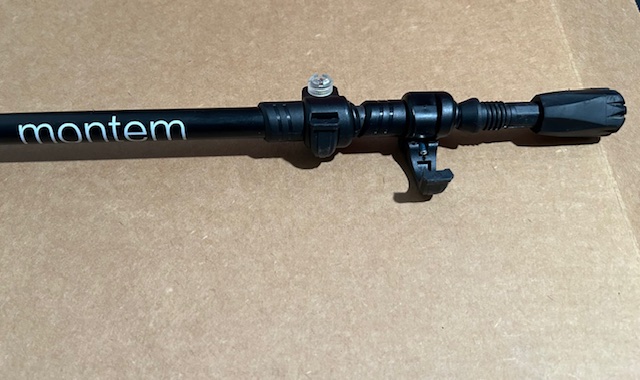
There are numerous studies to support the use of trekking poles, especially research that supports their use for health and safety. One study compared hikers in 3 different conditions; no backpack, a pack with 15% body weight and a pack with 30% body weight. Biomechanical analysis was performed blindly on the three groups and a significant reduction in forces on lower extremity joints (hip, knee, and ankle) was noted for all three groups when using poles compared to those not using poles.
Another study confirmed that trekking poles reduced the incidence of ankle fractures through improved balance and stability. Additional studies support the theory that trekking poles reduce exercise induced muscle soreness from hiking or walking steep terrain and another study found that while less energy is expended in the lower body muscles using poles, increase energy is used in the upper body; therefore, the net caloric expenditure is equal as it is simply transferred from the legs to the arms.
In conclusion, it is important to remember that trekking poles for hiking or distance walking are much more than a style statement. They are proven to be an invaluable tool for health, safety and wellness by reducing lower extremity joint stress, improving stability and balance, and enhancing efficiency for muscle recovery.
Sources: Medicine and Science in Sports and Exercise. The Complete Walker, by Colin Fletcher
Model: Andrea Molitoris, PT, DPT at Mackarey Physical Therapy

EVERY MONDAY – Read Dr. Paul J. Mackarey “Health & Exercise Forum!” via Blog
EVERY SUNDAY in "The Sunday Times" - Read Dr. Paul J. Mackarey “Health & Exercise Forum!” in hard copy
This article is not intended as a substitute for medical treatment. If you have questions related to your medical condition, please contact your family physician. For further inquires related to this topic email: drpmackarey@msn.com
Paul J. Mackarey PT, DHSc, OCS is a Doctor in Health Sciences specializing in orthopaedic and sports physical therapy in Scranton and Clarks Summit. Dr. Mackarey is in private practice and is an associate professor of clinical medicine at Geisinger Commonwealth School of Medicine. For all of Dr. Mackarey's articles, visit our exercise forum!
In addition to lowering blood pressure, this gentle form of exercise can help maintain strength, balance, flexibility and mental health and is an ideal activity for all ages!
This research was brought to my attention by my friend and mentor from Dalton, Peter Frieder, Chairman,Gentex Corporation and current Board Chair at WVIA. Peter is celebrating his birthday today with a number of years that clearly does not represent his physiological age, in great part due to his dedication to health and wellness. Happy Birthday and thank you!
According to a new study by the China Academy of Chinese Medical Sciences (CACMS), the ancient martial art practice of Tai Chi is effective in lowering blood pressure as much, if not more, than traditional aerobic exercise. For those with prehypertension or hypertension and are unable to tolerate the repetitive and prolonged weight bearing stresses of running, walking or cycling, these results have tremendous implications. The slow, gentle and controlled movements and positions of Tai Chi coupled with controlled breathing and meditation may be a valuable alternative, especially for those with aging muscles and joints. Improved strength, flexibility balance, posture and mental health are additional bonuses.
Tai Chi is multifaceted in that it combines martial arts, slow gentle and controlled movements, sustained postures, a focused and meditative mind, and controlled breathing. It is considered by many to be “meditation or medication in motion.”
Tai Chi involves slow-motion movements transitioning with control from one position to another. The positions have historically been named for the actions of animals, for example:

Deep and purposeful breathing, mental focus, body awareness and meditation are integral components of the exercise. The beauty of Tai Chi is not only in the physical form, but also in its safety for all levels of fitness. It is helpful for individuals from high level athletes to those with physical disabilities. The movements are natural and gentle without forcing the muscles and joints to extreme or uncomfortable positions. It is often used as an adjunct therapy in the wellness as well as rehabilitation of a variety of athletic (ACL surgery, joint replacements) and neurological conditions (Parkinson’s, MS, head trauma), to name a few. Based on the aforementioned Chinese study, Tia Chi can be applied as a technique to control or lower blood pressure, especially for those who cannot utilize traditional aerobic exercise.
Tai Chi has been found to offer many physical and mental benefits. Some of these include:
Muscle Strength – upper and lower body, trunk and core strength
Flexibility – participants report improved range of motion and flexibility of the spine and extremities
Balance and Proprioception – some studies report a reduction of falls due to a variety of sustained positionsand improved awareness of one’s body in space
Aerobic Conditioning - recent studies have found that participants have lower heart rate and blood pressure
Mental Health – through improved balance, strength, and flexibility, studies show participants have gained confidence and control as well as lower blood pressure and stress reduction.
All Tai Chi classes begin with four basic principles: warm-up, instruction, practice and breathing.
Warm-up- gentle easy motions to warm-up and loosen the joints and muscles to prevent injury.
Tai Chi Forms – “Short Forms” are beginner movements which are gentle, slow, and short in duration while “Long Forms” are more advanced.
Breath Work – gentle breathing combined with movement to relax the mind and focus energy
Don’t be intimidated by the language or history – Yang, Wu, Cheng are only brands of movements with a history of martial arts but this in no way impacts participation.
Get medical clearance – check with your physician to see if Tai Chi is safe for you. Some orthopedic or vestibular problems might require special attention.
Observe or take a beginner class – often available at local fitness clubs or senior centers. Research options in your area and find a friend to join you. Consider an introductory instructional video to get a feel for Tai Chi. (See local Tia Chi classes below)
Meet with an instructor – if it makes you more comfortable, make time to talk to an instructor before enrolling in a class.
Dress for success – wear loose-fitting clothes that allow for range of motion and comfortable shoes for balance and support.
Track your progress – use an app or keep a journal of your progress. Heart rate, blood pressure and endurance (the time you can hold a pose or tolerate a class) are easy to monitor.
Model: Lily Smith, University of Scranton Physical Therapy Student and PT aide at Mackarey Physical Therapy.
Sources: HarvardHealthPublishing; New Atlas; China Academy of Chinese Medical Sciences (CACMS); National Institutes of Health
Local Tai Chi Classes: Steamtown Yoga, Scranton, PA; Mission Yoga, Scranton, PA;Dragon’s Heart Tai Chi & Kung Fu, Clarks Summit, PA; Rothrocks Kung Fu & Tai Chi, Duryea, PA
For more information: HarvardHealth; www.taichihealth.com; www.treeoflifetaichi.com

EVERY MONDAY – Read Dr. Paul J. Mackarey “Health & Exercise Forum!” via Blog
EVERY SUNDAY in "The Sunday Times" - Read Dr. Paul J. Mackarey “Health & Exercise Forum!” in hard copy
This article is not intended as a substitute for medical treatment. If you have questions related to your medical condition, please contact your family physician. For further inquires related to this topic email: drpmackarey@msn.com
Paul J. Mackarey PT, DHSc, OCS is a Doctor in Health Sciences specializing in orthopaedic and sports physical therapy in Scranton and Clarks Summit. Dr. Mackarey is in private practice and is an associate professor of clinical medicine at Geisinger Commonwealth School of Medicine. For all of Dr. Mackarey's articles, visit our exercise forum!
Northeastern Pennsylvania is home to a large elderly population and many of the medical problems we expect to see are age related. Dedicated medical practitioners are in constant search for new knowledge and information to prevent or delay many age-related problems. One of the most devastating problems associated with aging is falling.
Loss of balance causes falls. Falls are a leading cause of injury and death. Thirty percent of women and thirteen percent of men over the age of sixty-five will fall. Twenty to thirty percent of these individuals suffer moderate to severe injuries. Preventing falls is not an easy task. A good understanding of the causes of loss of balance and knowledge of a few fall prevention suggestions can enhance your balance and reduce your risk of a fall.
The Falls Risk Self-Assessment below allows an individual to determine their risk of falling AND take the appropriate steps for prevention and treatment. The next three weeks will be dedicated to this topic to educate and inform readers and their families to make good decisions.
The Falls Risk Assessment is from the Centers for Disease Control (CDC).
WHAT IS YOUR RISK OF FALLING?
Add up the number of points for each YES answer. If you have scored 4 or more points you may be at risk for falling. Accordingly, 0-1 = Low Risk; 1-2 = Moderate Risk; 3-4 = At Risk; 4-5 = High Risk; 5-6 = Urgent; > 6 = Severe
Low Moderate At Risk High Risk Urgent Severe
0 1 2 3 4 5 6 7 8

NEXT MONDAY – Read Dr. Paul J. Mackarey “Health & Exercise Forum!” Next Monday Part I of III on Balance Disorders and Falls Prevention
Read all of Dr. Mackarey's articles at https://mackareyphysicaltherapy.com/forum/
This article is not intended as a substitute for medical treatment. If you have questions related to your medical condition, please contact your family physician. For further inquires related to this topic email: drpmackarey@msn.com
Paul J. Mackarey PT, DHSc, OCS is a Doctor in Health Sciences specializing in orthopaedic and sports physical therapy. Dr. Mackarey is in private practice and is an associate clinical professor of medicine at GCSOM.
This column is written at the request of Kathryn Sarrides, an exceptionally spry senior who lives happily in Green Ridge with her sage husband, Harry. They, like many their age, work hard to maintain their independence by engaging in physical activity and exercise as well as intellectual stimulation by playing bridge, reading books and staying socially active. Last week, Kathryn came to me with a very common problem among octogenarians and nonagenarians… she was concerned about her safety getting out of a chair, especially a chair that did NOT HAVE ARMS!
Falls are a leading cause of injury and death in seniors. Thirty percent of women and thirteen percent of men over the age of sixty-five will fall. Twenty to thirty percent of these individuals suffer moderate to severe injuries. While preventing falls is not an easy task, there are a few things to consider that may go a long way!
The National Institute of Health (NIH) recommends four areas of concentration for elderly persons to concentrate on in order to maintain safety and independence: strength, flexibility, balance and endurance. It will be the purpose of this column to recommend safe and practical tips to get out of a chair and exercises to keep you strong and limber enough to do it safely.
1. Scoot Your Butt to the edge of the chair
2. Tip Your Trunk Forward – over your bent knees
3. Push Off the Arms of the Chair – while leaning forward
4. IF THE CHAIR HAS NO ARMS – Place one hand on the chair seat and the other hand on your knee. Then push up with your arms (SEE PHOTO A)
5. Push From your Legs – at the same time you push with your arms
6. Stay Still Standing – for a few seconds after You get up …before you walk
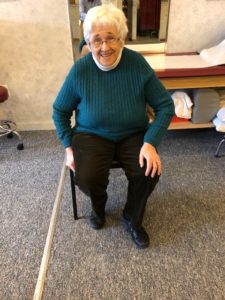
Strength Exercises involve using the muscles to move the arms and legs against resistance such as a weighted object, dumbbells, resistance bands, and body weight against gravity. Strength is necessary to perform daily activities such as: getting out of a chair, walking, lifting a half-gallon of milk, transferring to/from a shower safely.
These exercises are performed while sitting in a chair with backrest, slowly, 5 -10 repetitions, and 3-5 times per week. No weight is used in the beginning, only the weight of the arm against gravity. In 1-2 weeks a light 1-2 pound weight and light resistance band may be added.
Do these exercises while sitting in a chair with a backrest:
Chair Push-Ups – While sitting in a chair with arm rests, perform a push-up by pushing off the arms while pushing with your legs (PHOTO B)
Shoulder Shrug – shrug top of shoulders up toward the ears
Row the Boat – pull both arms back at a 45 degree angle with bent elbows as if “rowing a boat”
Elbow Bend/Extend – bend and straighten elbows
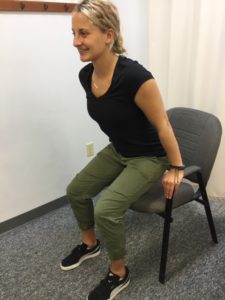
Do these exercises while sitting in a chair with a backrest:
Hip Hike – lift hip up 2-4 inches as if “marching” (PHOTO C)
Hip Spread – with heels on the floor, spread knees apart
Hip Squeeze – with heels on the floor, squeeze knees together
Leg Kicks – extend knee as if kicking the foot forward and up
Heel Raise – raise heel up with toe on floor
Toe Raise – raise toes up with heel on floor
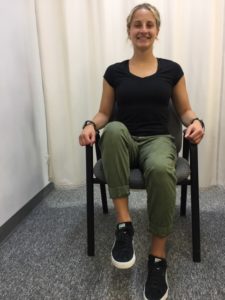
Do these exercises while Standing. Always hold onto a counter top or the back of a stable chair:
Standing Leg Curl – facing and holding onto the countertop (chair), bend the knee by bringing the foot back (PHOTO D)
Standing Hip Hike - facing and holding onto the countertop (chair), hike hip up as if marching (PHOTO E)
Standing Squat – facing and holding onto the countertop (chair), bend both knees to a 20-30 degree angle. Hold this position for 5-10 seconds.
Once you have mastered these exercises against gravity, then advance to using light weights or light resistance bands. Ankle weights are very inexpensive and can be purchased in 1 pound increments. Light resistance bands are available in yellow and red in colors.
Visit your doctor regularly and listen to your body.
Keep moving, eat healthy foods, exercise regularly, and live long and well!
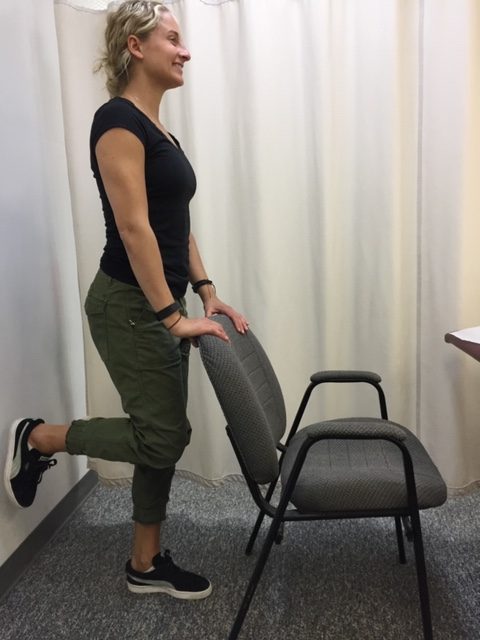

Read Dr. Mackarey’s "Health & Exercise Forum" every Monday in the Scranton Times-Tribune.
This article is not intended as a substitute for medical treatment. If you have questions related to your medical condition, please contact your family physician. For further inquires related to this topic email: drpmackarey@msn.com
Paul J. Mackarey PT, DHSc, OCS is a Doctor in Health Sciences specializing in orthopaedic and sports physical therapy. Dr. Mackarey is in private practice and is an associate professor of clinical medicine at Geisinger Commonwealth School of Medicine.